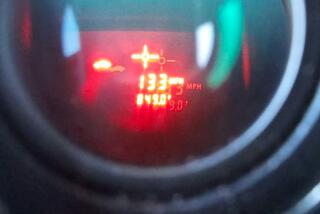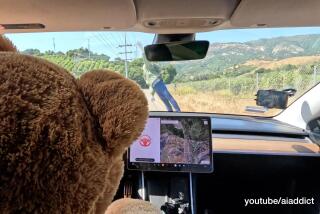When a car tells you how to drive
- Share via
Warning: This car may ignore commands by the driver. Any protest is futile.
Such a caution is not posted in front of the driver’s seat in any cars I have seen, but it seems increasingly appropriate.
Engineers have been designing features that allow electronic systems to take automatic action for more than a decade. The first wave of such systems included anti-lock brakes and more sophisticated recent systems include electronic stability control.
Who would quibble about such electronic systems that are faster and more precise than the hands and feet of mere mortals, whose reaction time stretches into the tenths of a second rather than thousandths of a second?
But as engineers delve deeper into the range of electronic control possibilities, such systems may very well cross over the boundaries of what vehicle owners want to accept.
Take the case of the Porsche Cayenne, a lovely and popular sport utility vehicle. The Cayenne has a feature that some drivers would find troublesome, obnoxious or even unacceptable, particularly those drivers who use both feet when driving.
People are taught not to drive this way but there are a million reasons why they do it. Mechanics know these drivers by the overheating and damage they cause their brakes and transmissions.
In the Cayenne, if a driver tries to put a foot on the brake and another on the accelerator while cruising in traffic, the vehicle’s electronic control system throttles back the engine. Even if a driver just happens to nudge the brake pedal with a left foot, it can trigger a power loss.
When Steve Schwartzer of Indian Wells bought his 2004 Cayenne and encountered a throttle back, he thought the car had a defect. It wasn’t until the third time he returned it to a dealership in Rancho Mirage that a Porsche factory rep showed up and explained that the car was designed to do that.
Schwartzer is not a two-footed driver, but managed to repeatedly trigger the throttle-back feature.
“We noticed right away that if you touch the brake while the car was running, the power would cut out,” Schwartzer said. “The motor keeps on running, but you don’t have any power.”
“They gave me some kind of a story that it is designed this way and that it is a safety feature,” he added. “It is a total lemon.”
Indeed, Schwartzer’s attorney, John Quincy Adams, said he wrote and demanded that Porsche buy back the vehicle under the California lemon law, but the company declined. Schwartzer did not want to pursue a lawsuit against the company.
Until now, Schwartzer has been a Porsche lover. The retired banking executive and his wife each drive Porsche Carreras. He bought the SUV to share with his wife, planning to haul his boat and grandchildren up to his mountain home, but he’s reluctant now to use it. He’s worried the engine will throttle back while he’s on the boat ramp and the vehicle will roll back into Big Bear Lake.
Porsche officials acknowledge that they designed the vehicle to throttle back when both the brake and accelerator are pushed simultaneously.
“It is a safety feature designed to protect the brakes from overheating or damaging the powertrain,” said Porsche spokesman Paul Seredynski.
The system activates only when the car is in motion, meaning that drivers at stoplights can still apply the brake and accelerator to make a quick getaway, he said. Because he can use the brake and accelerator from a stopped position, Schwartzer should have nothing to worry about on the boat ramp, he said.
Seredynski added that the system would allow a person to drive with a foot on the brake, so long as there was not enough pressure on the pedal to activate the brake light. I’m somewhat skeptical that most two-footed drivers could rest their left foot on the brake pedal lightly enough not to trigger the brake light switch at least sometimes.
Seredynski said he had never heard a complaint about the design until I called him last week to discuss the case of Schwartzer. The company sold 14,524 Cayenne’s last year in the U.S., representing more than half of all Porsche sales.
Perhaps Porsche officials need to talk more to customers. Ginny Becker, a Palm Desert real estate agent, said she had to trade in her Cayenne two months ago because she could not accept the throttle-back feature.
“I use two feet on occasion and it was a problem for me,” Becker said. “It just totally loses power. If you are pulling out onto the freeway or into traffic, it would stall out. I have clients in the car and I felt it was a safety problem.”
Becker, whose husband is a former Porsche dealer, points out that she has nothing bad to say about the company, but she traded in her vehicle for a Mercedes-Benz SL 500.
Porsche does not say the feature is designed to address sudden acceleration, but such a throttle-back system would potentially help prevent drivers from accelerating when they meant to brake, said Paul Green, a senior scientist at the Transportation Research Institute at the University of Michigan.
“Car companies are worried about it, given all the bad press,” Green said.
As engineers push further into automated systems, it is creating sharp debate about the limits of taking control away from drivers.
“You could say, ‘I am the customer and I want to do whatever I choose’,” Green said. “But if the manufacturer has data that shows the system can do better than the driver, why would you make it an option?”
*
Ralph Vartabedian can be reached at ralph.vartabedian@latimes.com.







